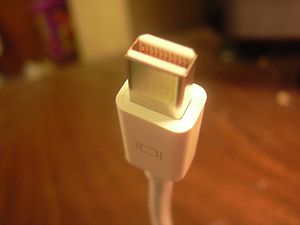
Back in 2008, Apple introduced the new Mini DisplayPort standard as the only video output method on the new MacBooks and LCDs. Mini DisplayPort is a freely-licensed VESA standard [1] and has now been adopted by a number of other display manufacturers, and is a miniaturized version of the original DisplayPort interface.
This week, the fourth revision of the HDMI high-definition video output connector was revealed in the form of HDMI D, weighing in at a mere fraction of the original HDMI connector size and intended for use with mobile and embedded high-definition video devices [2]. The new HDMI connector is expected to ship later this year, and is in direct competition with VESA’s Mini DisplayPort interface.
VESA is the international governing body for computer graphics standards, and has been designing video output standards since its conception in the late 80’s [3]. HDMI is a private group formed in 2002, and licenses its interfaces out to manufacturers at four cents a device + a $10,000 yearly fee.
HDMI doesn’t have many (if at all) advantages over DisplayPort, besides support for the xvYCC color space and Dolby audio codecs (as a part of the licensed technology). However, despite the licensing costs, HDMI has proved popular mainly due to its original mass adoption as a result of being signal-compatible with the DVI interface [4].
The new HDMI-D interface is smaller than the Mini DisplayPort, though both have the same maximum resolution/bandwidth and similar power requirements. The numbers are as follows:
| Mini DisplayPort | HDMI-D | DisplayPort | HDMI-A | |
|---|---|---|---|---|
| Max Resolution | 2560×1600 | 2560×1600 | 1920×1080 | 1920×1200 |
| Pin Count | 20 | 19 | 20 | 19 |
| Dimensions | 9.1 x 5.4 mm | 6.4 x 2.8 mm | 16 x 4.7 mm | 13.9 x 4.45 mm |
| Licensing | Free | $0.04/Device | Free | $0.04/Device |
References

just when you thought you had enough cables stuffed in a box in the shed
@HDMI dev
If the technology is essentially the fascism of DRM I shall not buy it.
I do not appreciate being treated like a criminal in my own house.
Seth, you will ‘buy’ whatever is on the device with the specs you want.
In other words, if you want to buy a new widget, and it turns out that the only widget with the feature set you want has a new HDMI-d connector built in as it’s only video interface, then by gosh I’m guessing your high ideals will go out the window.
Case in point, are you going to refuse to buy a Wide Screen TV simply because it has a HDMI connector built into it? Are you going to refuse to use that HDMI connector when it provides both better quality, and combines audio/video in one cable?
Let me be perfectly clear, I don’t like DRM anymore than you do. But I’m a realist, and if I want to buy the latest greatest widget, and all the newest latest greatest widgets come with proprietary hardware, I’m not going to punish or deprive myself based on the misguided belief that the mfg gives a rats fanny if I buy his product or not. He’s looking at total numbers, and removing my 1 from his bottom line is less than a statistical rounding error.
I agree with you that DRM sucks, but then again, so do death, taxes, and my mother-in-law. And unfortunately, I’ve got to live with them all.
Well it certainly sounds like it would be best if Mini DisplayPort won as there is no licensing cost, which means (ever so slightly) cheaper devices for all of us.
I suppose in the end though, if HDMI is better designed perhaps it is worth the 4c per device!
One of the other commentators brought up DRM. I don’t think DRM is relevent. I’m sure DRM could be implemented through Mini DisplayPort too unfortunately.
The average consumer honestly buys what comes with the device they purchase. The two ports seem to have pretty much the same functionality, so we are back to a Betamax vs VHS debate here. Whoever gets their technology to get adopted the widest and quickest will undoubtedly emerge as the victor…
@Highly
nope.
drm _generates_ piracy
I’ll go to whatever lengths necessary to be able to use media MY way
the VESA standard is superior to hdmi as it contains no essential bits for digital fascism
> a Wide Screen TV
Got Fury? ;P
> He’s looking at total numbers
Then he might care that I spend some of my monetary numbers on usenet instead of his media or widgets.
He will take notice because rather than whine I communicate my distaste to him directly
> I’ve got to live with them all.
only death is inescapable.. the others require varying degrees of effort.
you, dubious, seem to be very lazy.
that’s your realism
I bought this adapetr to use my Samsung tv (model LN46A650) as a second monitor plugged into my iMac (2007 core 2 duo model with the NVIDIA GeForce GT 130 graphics). While technically it does work, the image is letterboxed. There is about 2-4 inches of unused screen between the image and the bezel at all resolutions, and the refresh rate seems really slow. You can see image lag just by moving the cursor around. Since other people seem to have better results, I can only guess that it’s either an issue with this line of Samsung tvs or possibly an issue with the NVIDIA graphics card. Just be warned that the adapetr may not work as well as you expect on some devices.